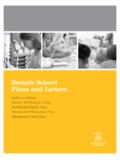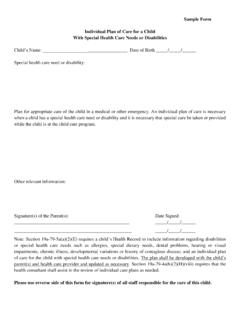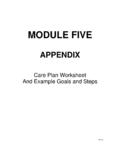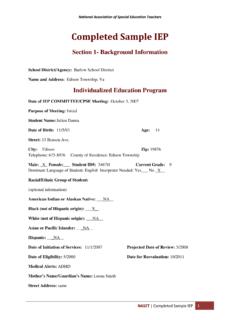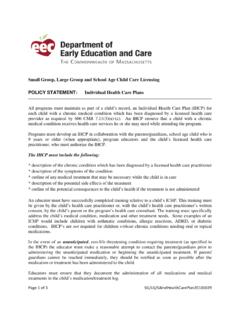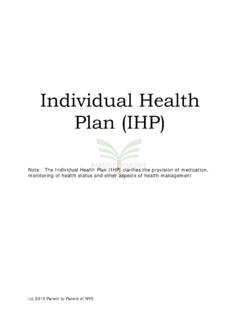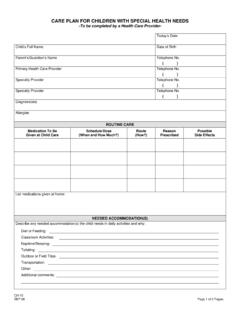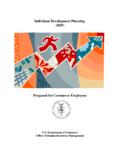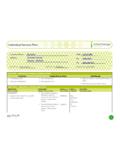Transcription of Individual Professional Development Plan
1 Developed by Susan Lindblom and Michelle Pounds Arkansas State University Childhood Services JoAnn Nalley, Director Funding provided by the Division of Child Care and Early Childhood Education Arkansas Early Childhood Individual Professional Development plan Arkansas Early Childhood Individual Professional Development plan Table of Contents Introduction 1 What is Professional Development ? What is an Individual Professional Development plan ? How does the Individual Professional Development plan work?Step 1: Self-Assessment 3 Self-Reflection Key Content Areas Child Growth and Development Learning Environment and Curriculum Positive Interactions and Guidance Family and Community Child Observation and Assessment health , Safety, and Nutrition Professional Development and Leadership Program Planning and Management Step 2: Determine Priorities and Set Goals 16 Determine Your Priorities A Guide to Setting Goals What Are Your Goals?
2 Step 3: Create The plan ! 19 Choose Your First Goal Create a Time Frame Identify Resources and Experiences Measuring Success and Reflection My Professional Development plan 1 AR Arkansas Early Childhood Individual Professional Development plan Introduction Welcome to the Arkansas Professional Development System! This document will be your guide to creating your own plan for increasing your knowledge and skills as an early care and education Professional . Before you get started, read through the entire guide so you will have a good idea of how the process works. Then give yourself plenty of time to think about what you have accomplished in the past, and where you want to go from here.
3 What is Professional Development ? What comes to mind when you hear the words Professional Development ? Many of us automatically think of the workshops and conferences we attend. While those are definitely important forms of Professional Development , there are other things that can help you grow as an early care and education practitioner. Obtaining a Child Development Associate (CDA) credential is a form of Professional Development , as is enrolling in college-level classes to work towards an associate, bachelor s, or master s degree. Receiving technical assistance or coaching from an experienced mentor can also be considered Professional Development . Any activity that helps you increase your knowledge and skills in ways that help you grow personally and professionally is considered Professional Development .
4 What is an Individual Professional Development plan ? There are many choices available when considering Professional Development opportunities. So many choices in fact, that it can almost seem overwhelming as you decide which workshops and trainings to attend. An Individual Professional Development plan (IPDP) can serve as a guide to help you organize your ideas about how you want to grow professionally and how you are going to accomplish that growth. An IPDP will help you think about the following things: How do I want to grow personally to be more effective in my job? This may be the most important thing to consider when setting goals for your Professional growth. An IPDP will help you identify your strengths as well as the areas in which you want to grow and learn more.
5 What information would help me work more effectively with a specific child, family, or group of children? Often you will encounter a particular need within a group of children. Having a specific goal related to this need on your IPDP can give you a timeline to quickly focus on resources, learn about that need, and apply what you have learned to your situation. How can my personal goals help my program be more effective as a whole? Sometimes a school or center as a whole has program-wide goals. An IPDP can also incorporate those goals as part of your plan . 2 AR How does the Individual Professional Development plan work? Step 1: Self-Assessment A good Professional Development plan starts with a self-assessment.
6 A self-assessment gives you an opportunity to think about the areas of your job in which you already have knowledge and skills, and the areas about which you would like to learn more. Step 2: Determine Priorities and Set Goals Once you have completed a self-assessment, determine which areas of your job are the most important to you right now. Set goals for learning and strengthening your skills in those areas. Step 3: Create the plan A Professional Development plan allows you to create a time frame for working on your goals and gives you the opportunity to think about what resources you will need to accomplish them. It also allows you to create regular check-in points with a supervisor or mentor and an opportunity to reflect on your work in completing your Professional goals.
7 3 AR Step 1: Self-Assessment Self-Reflection Professional Development is a lot like a road trip. In order to get anywhere, you have to know two things: where you are and where you are going. If you know those two things, you can plan your route. Take a few minutes to think about where you are and where you want to go. This will determine the route you take to get there. I currently work with: Young Infants (birth to 8 months) Mobile Infants (8-18 months) Toddlers (18-36 months) 3- year olds 4- year olds 5- year olds School-age children (6-12 years) Adults I would like to work with _____ in the future. My current position is: Lead Teacher Assistant Teacher/Paraprofessional Floater Administrator (owner/director/site supervisor) Support Staff (secretary, kitchen staff) Trainer/Consultant/Coach Other _____ I would like to be a _____ in the future.
8 I currently have a: High School Diploma Child Development Associate (CDA) Associate Degree Bachelor s Degree Master s Degree Doctorate I would like to earn my _____ in the future. 4 AR I have a lot of experience with: _____ _____ _____ _____ I know a lot about: _____ _____ _____ _____ I am interested in: _____ _____ _____ _____ I would like to strengthen: _____ _____ _____ _____ I want to learn more about: _____ _____ _____ _____ 5 AR The Arkansas Key Content Areas Everyone has strengths in different areas of their work with young children and families. Your strengths may be in areas in which you have had a lot of training or experience, have an interest or curiosity, or feel you have a natural talent or ability.
9 Eight Key Content Areas guide Professional Development for early care and education practitioners in Arkansas. These Key Content Areas define what early care and education professionals should know and understand in order to provide quality experiences for children, regardless of the setting in which care and education occurs. Each Key Content Area is broken down into a list of competencies for Foundation, Intermediate, and Advanced level practitioners that better define those things that early care and education professionals should know and understand. A copy of the full Key Content Areas and Core Competencies document is available for download on the TAPP Registry website. There are descriptions of each competency area in this document which you may find helpful when completing the chart for each Key Content Area.
10 The Arkansas Key Content Areas are: Child Growth and Development Learning Environment and Curriculum Positive Interactions and Guidance Family and Community Child Observation and Assessment health , Safety, and Nutrition Professional Development and Leadership Program Planning and Management 6 AR The next few pages will provide you with a look at the eight Key Content Areas and give you a chance to think about your strengths, knowledge and experience in each area. For each Key Content Area you have been given a chart that allows you to record your thoughts on your strengths and knowledge for each competency, as well as the competencies about which you would like to learn more. For each competency, you will determine your level of knowledge.

